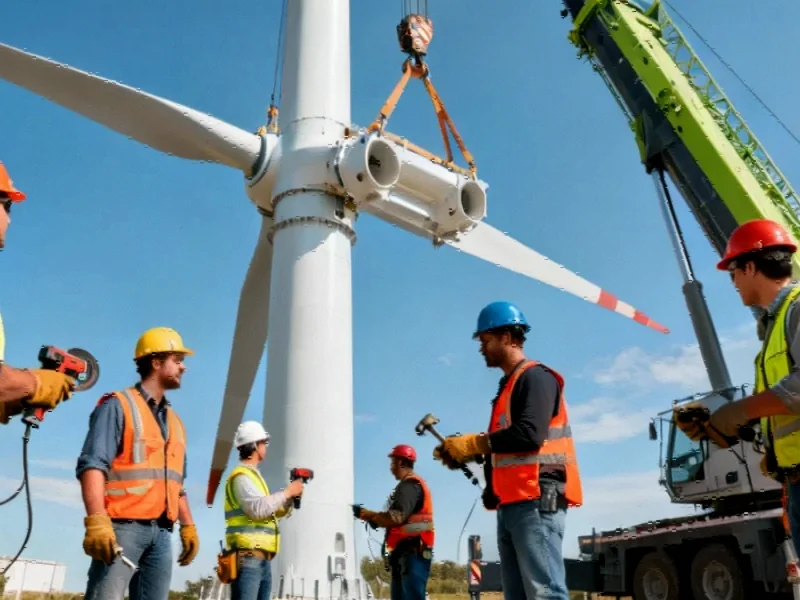The Clean Energy Employment Revolution
The United Kingdom is on the brink of an unprecedented employment transformation, with the clean energy sector projected to generate 860,000 jobs by 2030. This represents a doubling of the current workforce and signals a fundamental shift in the nation’s industrial landscape. Unlike previous economic transitions that often left communities behind, this green jobs boom is designed to spread opportunity across every region of the country.
Energy Secretary Ed Miliband emphasized the government’s commitment to ensuring this transition benefits workers nationwide: “Our plans will help create an economy in which there is no need to leave your hometown just to find a decent job. Thanks to this government’s commitment to clean energy, a generation of young people in our industrial heartlands can have well-paid, secure jobs.”
Major Projects Driving Employment Growth
The employment surge is being fueled by both government policy and substantial private investment, with over £50 billion flowing into the sector since last July alone. Flagship projects include the Sizewell C nuclear plant, which will support up to 10,000 jobs at peak construction, and the Rolls-Royce small modular reactor programme, expected to create 3,000 roles.
Carbon capture initiatives represent another significant employment driver. Projects like Acorn in Scotland and Viking in the North East will add 35,000 jobs, including 1,000 apprenticeships. When combined with ongoing carbon capture, usage and storage initiatives in the North West and Teesside, these developments position clean energy as one of the UK’s largest sources of industrial employment. These industry developments demonstrate how strategic investment can create sustainable job growth.
Comprehensive Workforce Development Strategy
For the first time, the UK government will publish a national plan specifically designed to train the next generation of clean energy workers. The strategy centers on five new Technical Excellence Colleges dedicated to equipping young people with skills needed for careers in renewables, nuclear, and advanced energy systems.
Pilot schemes in Cheshire, Lincolnshire and Pembrokeshire—worth a combined £2.5 million—will support new training centers, courses, and career advice. Education providers, industry leaders, and local authorities will collaborate under a cohesive framework that aligns skills training with real-world demand across 31 priority occupations. This coordinated approach to workforce development represents a significant advancement in how the UK clean energy sector prepares for future challenges.
Expanding Access to Clean Energy Careers
The government is implementing targeted initiatives to ensure clean energy jobs are accessible to diverse segments of the workforce. In partnership with Mission Renewable, a veterans’ transition program will match ex-service members with roles in wind, solar, and nuclear energy.
Additional programs will provide training pathways for ex-offenders, school leavers, and the unemployed—tapping into a pool of over 13,000 people who already possess relevant skills from previous industries. Workers from traditional oil and gas backgrounds will benefit from up to £20 million in retraining funds, with the successful Aberdeen skills pilot being expanded nationwide. These efforts are complemented by pioneering dry-type transformer innovations that are creating new technical roles.
Superior Compensation and Worker Protections
Clean energy jobs not only offer quantity but quality. Entry-level roles in the sector pay 23% more than equivalent positions elsewhere, while jobs in wind, nuclear, and grid infrastructure offer average salaries exceeding £50,000—significantly above the UK national average of £37,000.
The government’s new Fair Work Charter, developed with trade unions, will guarantee strong pay, secure contracts, and safe conditions for all clean energy workers. New legislation will extend employment protections, including the National Minimum Wage, to offshore clean energy workers beyond UK territorial waters. These protections are particularly important as submerged and orbital technologies create new workplace environments.
Global Context and Broader Implications
The UK’s clean energy transformation aligns with broader education reforms announced by the Prime Minister, setting a target for two-thirds of young people to engage in higher-level learning—whether academic, technical, or through apprenticeships—by age 25. This comprehensive approach recognizes that building a sustainable future requires both technological innovation and human capital development.
As the sector expands, it’s worth noting how these market trends reflect a global shift toward sustainable energy infrastructure. The UK’s success in creating quality jobs while pursuing environmental goals offers a model that other nations might emulate. The integration of African power infrastructure transformation approaches demonstrates the interconnected nature of global energy transitions.
From the industrial heartlands of Teesside to the coastal wind farms of the East of England—where 60,000 people are expected to be employed by 2030—the clean energy revolution is reshaping Britain’s economic future. As this transformation accelerates, it creates opportunities not just in traditional energy roles but also in supporting creative technology projects that enhance operational efficiency.
Even as the energy sector evolves, it’s important to recognize that related innovations across different industries often share common technological foundations. The UK’s clean energy jobs surge represents more than just employment statistics—it signifies a fundamental reimagining of how economic growth, environmental sustainability, and social equity can be pursued simultaneously, creating a blueprint for a fairer, more prosperous future for all workers.
This article aggregates information from publicly available sources. All trademarks and copyrights belong to their respective owners.
Note: Featured image is for illustrative purposes only and does not represent any specific product, service, or entity mentioned in this article.



